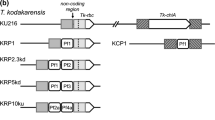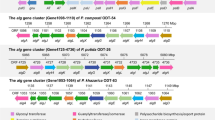Abstract
About 1500 hybrid broad-host-range plasmids from a genomic library ofPseudomonas saccharophila were individually transferred by conjugation fromEscherichia coli toAlcaligenes eutrophus. Direct selection for pentose-utilizing transconjugants yielded three clones capable of growth on xylose. Growth ofP. saccharophila as well as the transconjugants ofA. eutrophus on xylose was relatively slow, exhibiting doubling times of about 9.5 h. Plasmid pGN3 harbored by one transconjugant contained a 28-kb DNA insert, 16.4 kb of which comprised the minimal information required for xylose utilization byA. eutrophus. At least thexyl genes encoding xylose isomerase and xylulokinase were located within this region, as indicated by their induction during growth ofA. eutrophus (pGN3) on xylose. Southern hybridizations with a heterologous gene probe confirmed the presence of thesexyl genes. In bothP. saccharophila andA. eutrophus (pGN3), low activities of several enzymes operating in the pentose phosphate and Entner-Doudoroff pathways might limit the rate of xylose catabolism.
Similar content being viewed by others
Literature Cited
Auling G, Dittbrenner M, Maarzahl M, Nokhal T, Reh M (1980) Deoxyribonucleic acid relationships among hydrogenoxidizing strains of the generaPseudomonas, Alcaligenes andParacoccus. Int J Syst Bacteriol 30:123–128
Batt CA, Jamieson AC, Vandeyar MA (1990) Identification of essential histidine residues in the active site ofEscherichia coli xylose (glucose) isomerase. Proc Natl Acad Sci USA 87:618–622
Birnboim HC, Doly J (1979) A rapid alkaline extraction procedure for screening recombinant plasmid DNA. Nucleic Acids Res 7:1513–1523
Blackkolb F, Schlegel HG (1968) Katabolische Repression und Enzymhemmung durch molekularen Wasserstoff beiHydrogenomonas. Arch Mikrobiol 62:129–143
Bowien B, Schlegel HG (1972) Der Biosyntheseweg der RNS-Ribose inHydrogenomonas eutropha Stamm H16 undPseudomonas facilis. Arch Mikrobiol 85:95–112
Bowien B, Windhövel U, Yoo J-G, Bednarski R, Kusian B (1990) Genetics of CO2 fixation in the chemoautotrophAlcaligenes eutrophus. FEMS Microbiol Rev 87:445–450
Byrom D (1987) Polymer synthesis by microorganisms: technology and economics. Trends Biotechnol 5:246–250
Clarke L, Carbon J (1976) A colony bank containing synthetic ColE1 hybrid plasmids representative of the entireE. coli genome. Cell 9:91–99
Davis DH, Doudoroff M, Stanier RY, Mandel M (1969) Proposal to reject the genusHydrogenomonas: taxonomic implications. Int J Syst Bacteriol 19:375–390
Davis DH, Stanier RY, Doudoroff M, Mandel M (1970) Taxonomic studies on some gram negative polarly flagellated “hydrogen bacteria” and related species. Arch Mikrobiol 70:1–13
Fraenkel D (1987) Glycolysis, pentose phosphate pathway, and Entner-Doudoroff pathway. In: Neidhardt FC (ed)Escherichia coli andSalmonella typhimurium—cellular and molecular biology, vol. 1. Washington, D.C.: American Society for Microbiology, pp 142–150
Ghangas GS, Wilson DB (1984) Isolation and characterization of theSalmonella typhimurium LT2 xylose regulon. J Bacteriol 157:158–164
Gottschalk G, Eberhardt U, Schlegel HG (1964) Verwertung von Fructose durchHydrogenomonas H16 (I.). Arch Mikrobiol 48:95–108
Holmes DS, Quigley M (1981) A rapid boiling method for the preparation of bacterial plasmids. Anal Biochem 114:193–197
Jeffries TW (1983) Utilization of xylose by bacteria, yeasts, and fungi. Adv Biochem Eng Biotechnol 27:1–32
Klintworth R, Husemann M, Weissenborn C, Bowien B (1988) Expression of the plasmid-encoded phosphoribulokinase gene fromAlcaligenes eutrophus. FEMS Microbiol Lett 49:1–6
Knauf CV, Nester EW (1982) Wide host range cloning vectors: a cosmid clone bank of anAgrobacterium Ti plasmid. Plasmid 8:45–54
Kreuzer P, Gärtner D, Allmansberger R, Hillen W (1989) Identification and sequence analysis of theBacillus subtilis W23xylR gene andxyl operator. J Bacteriol 171:3840–3845
Kunioka M, Kawaguchi Y, Doi Y (1989) Production of biodegradable copolyesters of 3-hydroxybutyrate and 4-hydroxybutyrate byAlcaligenes eutrophus. Appl Microbiol Biotechnol 30:569–573
Kusian B, Yoo J-G, Bednarski R, Bowien B (1992) The Calvin cycle enzyme pentose-5-phosphate 3-epimerase is encoded within thecfx operons of the chemoautotrophAlcaligenes eutrophus. J Bacteriol 174:7337–7344
Lawlis VB, Dennis MS, Chen EY, Smith DH, Henner DJ (1984) Cloning and sequencing of the xylose isomerase and xylulose kinase genes ofEscherichia coli. Appl Environ Microbiol 47:15–21
Lowry OH, Rosebrough NJ, Farr AL, Randall RJ (1951) Protein measurement with the Folin phenol reagent. J Biol Chem 193:265–275
Marmur J (1961) A procedure for the isolation of deoxyribonucleic acids from microorganisms. J Mol Biol 3:208–218
Nandadasa HG, Andreesen M, Schlegel HG (1974) The utilization of 2-ketogluconate byHydrogenomonas eutropha H16. Arch Microbiol 99:15–23
Posno M, Heuvelmans PTHM, van Giezen MJF, Lokman BC, Leer RJ, Powels PH (1991) Complementation of the inability ofLactobacillus strains to utilized-xylose withd-xylose catabolism-encoding genes ofLactobacillus pentosus. Appl Environ Microbiol 57:2764–2766
Pries A, Steinbüchel A, Schlegel HG (1990) Lactose- and galactose-utilizing strains of poly(hydroxyalkanoic acid)-accumulatingAlcaligenes eutrophus andPseudomonas saccharophila obtained by recombinant DNA technology. Appl Microbiol Biotechnol 33:410–417
Rygus T, Hillen W (1992) Catabolite repression of thexyl operon inBacillus megaterium. J Bacteriol 174:3049–3055
Sambrook J, Fritsch EF, Maniatis TE (1989) Molecular cloning: a laboratory manual, 2nd ed. Cold Spring Harbor, N.Y.: Cold Spring Harbor Laboratory Press
Schäferjohann J, Yoo J-G, Kusian B, Bowien B (1993) Thecbb operons of the facultative chemoautotrophAlcaligenes eutrophus encode phosphoglycolate phosphatase. J Bacteriol 175: 7329–7340
Schlegel HG, Gottschalk G (1965) Verwertung von Glucose durch eine Mutante vonHydrogenomonas H16. Biochem Z 341:249–259
Schlegel HG, Trüper HG (1966) Repression of enzyme formation inHydrogenomonas strain H16G+ by molecular hydrogen and by fructose. Antonie van Leeuwenhoek 32:277–292
Schlegel HG, Gottschalk G, von Bartha R (1961) Formation and utilization of poly-β-hydroxybutyric acid by Knallgas bacteria (Hydrogenomonas). Nature 191:463–465
Simon R, Priefer U, Pühler A (1983) A broad host range mobilization system for in vivo genetic engineering: transposon mutagenesis in gram negative bacteria. BioTechnology 1:784–791
Sizemore C, Wieland B, Götz F, Hillen W (1992) Regulation ofStaphylococcus xylosus xylose utilization genes at the molecular level. J Bacteriol 174:3042–3048
Spaink HP, Okker RJH, Wijffelman CA, Pees E, Lugtenberg BJJ (1987) Promoters in the nodulation region of theRhizobium leguminosarum Sym plasmid pRL1JI. Plant Mol Biol 9:27–39
Wilkie KCB (1979) The hemicelluloses of grasses and cereals. Adv Carbohydr Chem Biochem 36:215–264
Windhövel U, Bowien B (1991) Identification ofcfxR, an activator gene of autotrophic CO2 fixation inAlcaligenes eutrophus. Mol Microbiol 5:2695–2705
Author information
Authors and Affiliations
Rights and permissions
About this article
Cite this article
Buchholz, B., Nordsiek, G., Meister, M. et al. Transfer of genes fromPseudomonas saccharophila to construct xylose-utilizing strains ofAlcaligenes eutrophus . Current Microbiology 29, 157–162 (1994). https://doi.org/10.1007/BF01570757
Issue Date:
DOI: https://doi.org/10.1007/BF01570757




